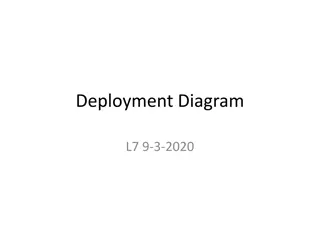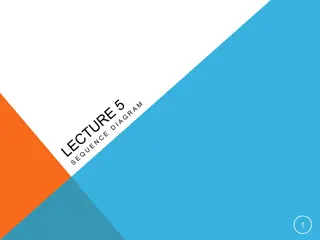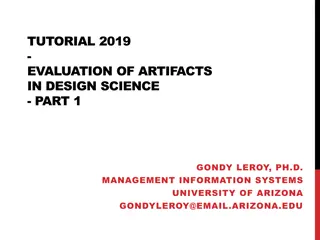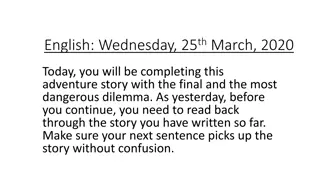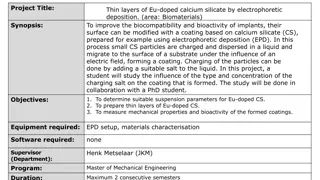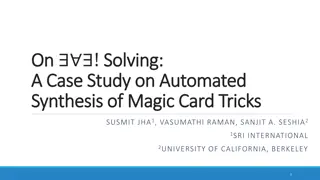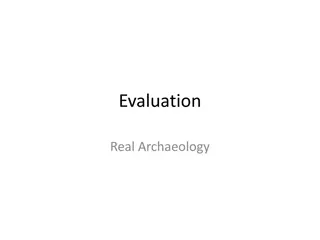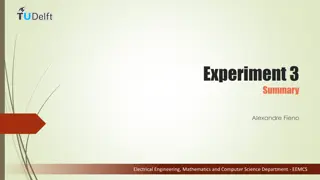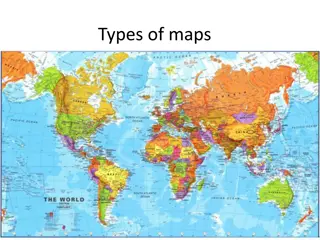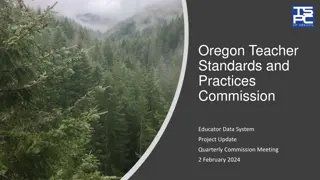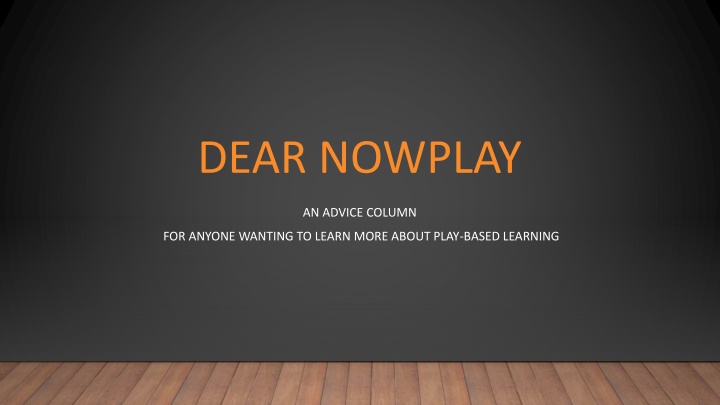
Play-Based Learning in the Classroom
Explore the dynamic nature of play-based learning, where classrooms are lively, inclusive, and encourage hands-on exploration. Teachers actively engage with students, fostering problem-solving skills and language development through play. Discover how to create an effective play-based environment that supports children's learning experiences.
Download Presentation

Please find below an Image/Link to download the presentation.
The content on the website is provided AS IS for your information and personal use only. It may not be sold, licensed, or shared on other websites without obtaining consent from the author. If you encounter any issues during the download, it is possible that the publisher has removed the file from their server.
You are allowed to download the files provided on this website for personal or commercial use, subject to the condition that they are used lawfully. All files are the property of their respective owners.
The content on the website is provided AS IS for your information and personal use only. It may not be sold, licensed, or shared on other websites without obtaining consent from the author.
E N D
Presentation Transcript
DEAR NOWPLAY AN ADVICE COLUMN FOR ANYONE WANTING TO LEARN MORE ABOUT PLAY-BASED LEARNING
DEAR NOWPLAY TEAM, WHAT DOES A PLAY BASED APPROACH LOOK LIKE, SOUND LIKE AND FEEL LIKE IN THE CLASSROOM? A play-based approach is likely going to be loud and messy and that s okay because students are learning from one another and they re exploring their environment. Sensory and tactile exploration build children s experience and knowledge. In a play-based classroom, you re not likely to see a teacher at their desk. A play-based teacher will always be out and about in the classroom, on the floor playing with students, or working one on one in a different space. Don t expect the classroom to be static; there will be constant movement of everyone. Constructing the space or physical environment to support exploration and play will also be needed. The arrangement of tables, what materials are used, and where they are placed should all be arranged in a way that encourages children to engage in independent exploration. Using centres (picture examples at www.curriculum.org), where a number of tables are set up in a U-shape, can help designate areas for open play. If tables aren t available, setting a centre on designated carpet space is just as good! The goal with the setting of a play-based classroom is to create multiple spaces to allow children to explore different things. A play-based classroom will feel inclusive. Everyone should be constantly involved in what s going on in the classroom, and if they re not, it is the educator s responsibility to engage them. There are moments in play-based learning where students might not look engaged; however, they are engaged. There s a difference between a student sitting on their own and not engaging versus a student who is quietly observing and learning from other s active play. Educators need not always bring the quiet student into the play. At times, we need to let students observe play and see how they can draw each other into the play situation without the educators effort. It is important to be mindful of the classroom space and what is happening in the space to judge when you should get involved. You want to honour each child s individuality and personality which may require a step back at times to let the situation unfold naturally. For video clips on effective play-based learning in kindergarten, see Kindergarten matters: Intentional Play-based learning (www.curriculum.org).
DEAR NOWPLAY TEAM, IS IT OK FOR THE TEACHER TO BE A PARTICIPANT IN GROUP PLAY WITH CHILDREN IN THE CLASSROOM? Absolutely! By teachers being participants in the play, they can more easily follow the play of the children and communicate naturally with them. Being involved in the play allows teachers to strategically create a problem that directly connects to what is happening in the play which then lets the students flex and develop their problem-solving to figure it out. When you re playing with students, a wide variety and number of teachable moments can come up that you can use to the children s benefit. Involvement in play also allows the teacher to be responsive to essentially everything students provide you with. You can naturally communicate with children, both verbally and non-verbally, to build their language development and competence. By being involved, objects can also be introduced into play. Keep in mind though, while you re engaged in play, that you should listen with warm attentiveness. This means that you shouldn t talk too much, and you shouldn t ask too many questions. Rather, go with the flow and whatever happens, happens. Don t feel like you have to always intervene or be fully involved with the play situation. Be aware of how the play is unfolding and engage with students as needed. Observing isn t necessarily disengagement; it s a choice to observe children s play and competencies. When you do choose to become involved in a play situation, be mindful of how you enter and exit the interaction. You don t want to be abrupt or commanding, but gently guide when needed to foster their thinking and doing. No matter what happens, you will learn from the play experience. You may learn how to do it differently next time if the plan doesn t work out well, and you ll learn what works and doesn t work for each particular group. You will also be able to see students competence to help you decide where to help guide them next.
DEAR NOW PLAY TEAM, WHAT IF THE STUDENTS PLAY TAKES A DIFFERENT DIRECTION THAN WHAT I, AS THE TEACHER, HAD PLANNED? That is the best learning ever! It may be difficult for some teachers (e.g., perhaps during an evaluation year), however, play should be a place where children do what they want to do. Even if there are some dark sides of play (e.g., playing war, modeling drug/alcohol use), it s not always necessary to intervene. Such behaviours coming out in play gives teachers a way to look at what kids are thinking about and working through in their lives. As an educator, behaviours and topics of discussion modeled in play illustrate interests and what is on children s minds. These behaviours or topics may not always be happy or positive things, but that is reality and it is informative. For more information on how learning takes place and the philosophy and practices that support the understanding of learning in the early years see How does learning happen found at www.edu.gov.on.ca
DEAR NOW PLAY TEAM, DO CHILDREN PLAY DIFFERENTLY WITH OPEN-ENDED PROPS VERSUS WITH TOYS? Different types of props or toys can bring out different types of play and creativity. With props, children can discuss a wide variety of themes or topics that are open to their choice. With specific toys, for example a firetruck, kids tend to use less creative responses and will be more likely to use more context-specific responses. Open-ended props lead children to be more independent and allows them to negotiate their own meanings of the props during play. With open-ended props, children can build their own thinking and narratives about the topic(s) as they are not restricted by the context of the toys. With open-ended props, possibilities are nearly endless, but with toys or specific toys kids parrot or repeat information that is very context specific. Both types of materials are important but may achieve different outcomes or goals.
DEAR NOW PLAY TEAM, WHAT IF I DON T HAVE A LOT OF RESOURCES OR MATERIALS IN MY CLASSROOM? HOW CAN I STILL ENCOURAGE PLAY? Not all children need toys or props to play, but having a good environment to encourage exploration and creativity will help. The classroom doesn t have to be the only location that play takes place. Learning can occur outdoors by using place- based learning (see www.naturalcuriosity.ca). We can take learning outside into natural spaces by going on nature walks, for example. Developing your skills to engage students in learning outside of the classroom will come with practice so if you are limited in the classroom, go elsewhere! The Learning for a Sustainable Future website also provides information regarding using resources that you have available at hand (www.lsf-lst.ca).
DEAR NOW PLAY TEAM, HOW DO I BEST WORK WITH SOMEONE WHO IS A BIT STUCK IN THE OLD PARADIGM? HOW CAN I SHOW THEM THE POWER OF PLAY? Some may think that play isn t learning, but children are constantly learning during play. Kids can watch and learn during play and through active play themselves. Filling out a worksheet isn t the same type of learning as what occurs during real-world play. Guidelines aren t always needed even though students may ask for them that just represents one type or one genre of learning. Giving children choice and options in their learning and play will help them become independent thinkers. To help convince an educator that the play-based approach to learning is an effective one, refer them to The Fundamentals of Play-Based Learning (see information at the end) and perhaps give them opportunities to visit other classrooms that have been doing play based learning. Try to help them connect with people that have experience with this educational format to help them build their confidence and comfort with the play- based approach. It is also important to help them feel like you re behind them 100% no matter if the change results in a temporary setback or an excellent outcome. You need support them and trust that the process will unfold in a successful way. It may be hard for teachers new to the play- based approach to shift their teaching style, especially if they re not comfortable with it, but support them to help them through the change and help them find the value in the experience. Slow and steady wins the race don t mandate the change, work through it together to make it a success. Some guidance will be needed, but it s an evolution.
DEAR NOW PLAY TEAM, WHAT KIND OF LANGUAGE CAN WE USE THAT WILL STIMULATE GROWTH AND DEEPER THINKING? There are a variety of questions and talking styles that will help foster children s language development during play. Using open-ended questions promotes higher level thinking and encourages curiosity without giving answers, provokes use of rich language, and promotes reciprocal conversation between the child, educator, and other children. Ensure that you have an open mind with an inquiry stance where you don t provide the answer to the child but helps them discover the answer for themselves. Refer to the Edugains website (www.edugains.ca) for additional resources on oral language and literacy in children as well as a variety of other educational materials. The Balanced Literacy Diet (www.oise.utoronto.ca) also provides a number of resources on oral language such as what it is, how to teach it, and assess it. The website also provides video samples of such activities (which are called recipes).
DEAR NOW PLAY TEAM, IT S HARD TO MAKE MATH EDUCATION PLAY BASED. WHAT RESOURCES AND PLAY-BASED ACTIVITIES MIGHT HELP ME DEEPEN MATHEMATICS LEARNING AND LITERACY IN MY CLASSROOM? A variety of websites and materials focus on math and the importance of play. The Learn, Teach, Lead (www.learnteachlead.ca) website has incredible research on specific topics (e.g., mathematics, literacy) and provides monographs related to searchable topics to help you implement them in your classroom. How Children Learn is a resource specifically related to elementary (primary) children regarding how they learn which may help inform practices in the classroom. Kathy Bruce at Trent University (www.trvlc.com or www.tmerc.ca) also provides a number of mathematics resources for educators including activities to implement in the classroom. Jo Boaler has an online math course for teachers that is reasonable priced and can be completed as a group. It s completed at your own pace and you receive a certificate once finished. It is a great resource for professional Math learning. Ontario Association of Math Educators (www.oame.ca) also has an excellent website with resources for teachers regarding teaching math.
Thank you for your questions and we hope that our responses have been informative and helpful! We would like to close our column with a quote that highlights the importance of play in learning: Play nourishes every aspect of children s development. It forms the foundation of intellectual, social, physical and emotional scales necessary for success in school and life. Play paves the way for learning. (From Kindergarten Matters: Intentional Play-based Learning Ontario Ministry of Education: www.curriculum.org)
Fundamental Principles of Play-Based Learning 1. Play is recognized as a child s right, and it is essential to the child s optimal development. The United Nations Convention on the Rights of the Child recognizes the right of the child to engage in play appropriate to the age of the child and to participate freely in cultural life and the arts . 1 Play is essential to the development of children s cognitive, physical, social, and emotional well-being. The Association for Childhood Education International (ACEI) recognizes play as necessary for all children and critical to children s optimal growth, learning, and development from infancy to adolescence.2 Educators recognize the benefits of play for learning and engage in children s play with respect for the children s ideas and thoughtful attention to their choices. 1 Article 31. Convention on the Rights of the Child (Entry into force 2 September 1990), United Nations Human Rights Office of the High Commissioner. Retrieved on January 14, 2016 from http://www.ohchr.org/en/professionalinterest/pages/crc.aspx. 2 J.P. Isenberg and N. Quisenberry, A Position Paper of the Association of Childhood Education International Play: Essential for All Children . Childhood Education (2002), 79 (1), p. 33.
2. All children are viewed as competent, curious, capable of complex thinking, and rich in potential and experience. In play-based learning, educators honour every child s views, ideas, and theories; imagination and creativity; and interests and experiences, including the experience of assuming new identities in the course of learning (e.g., I am a writer! ; I am a dancer! ). The child is seen as an active collaborator and contributor in the process of learning. Together, educators and learners plan, negotiate, reflect on, and construct the learning experience. Educators honour the diversity of social, cultural, and linguistic backgrounds represented among the children in the classroom, and take each child s background and experiences into account when interpreting and responding to the child s ideas and choices in play.
3. A natural curiosity and a desire to explore, play, and inquire are the primary drivers of learning among young children. Play and inquiry engage, challenge, and energize children, promoting an active, alert, and focused state of mind that is conducive to learning. Children s choices in play are the best starting points for the co-construction of learning with the child. Educators respond to, challenge, and extend children s learning in play and inquiry by: Observing Listening Questioning Provoking3 Providing descriptive feedback Engaging in reciprocal communication and sustained conversations Providing explicit instruction at the moments and in the contexts when it is most likely to move a child or group of children forward in their learning. 3 In education, the term provoking refers to provoking interest, thought, ideas, or curiosity by various means for example, by posing a question or challenge, introducing a material, object, or tool; creating a new situation or event; or revisiting documentation. Provocations spark interest, and may create wonder, confusion, or even tension. They inspire reflection, deeper thinking, conversations, and inquiries, to satisfy curiosity and resolve question. In this way, they extend learning.
4. The learning environment plays a key role in what and how a child learns. A learning environment that is safe and welcoming supports children s well-being and ability to learn by promoting the development of individual identity and by ensuring equity and a sense of belonging for all. Both in the classroom and out of doors, the learning environment allows for the flexible and creative use of time, space, and materials in order to respond to children s interests and needs, provide for choice and challenge, and support differentiated and personalized instruction and assessment. The learning environment is constructed collaboratively and through negotiation by children and educators, with contributions from family and community members. It evolves over time in response to children s developing strengths, interests, and abilities. A learning environment that inspires joy, awe, and wonder promotes learning. Ensuring equity is one of the four goals outlined in the Ministry of Educations Achieving Excellence: A Renewed Vision for Education in Ontario (2014, p. 8), which states: The fundamental principle driving this [vision] is that every student has the opportunity to succeed, regardless of ancestry, culture, ethnicity, gender, gender identity, language, physical and intellectual ability, race, religion, sex, sexual orientation, socio-economic status or other factors.
5. In play-based learning programs, assessment supports the child learning and autonomy as a learner. In play-based learning, educators, children, and family members collaborate in ongoing assessment for and as learning to support children s learning and their cognitive, physical, social, and emotional development. Assessment in play-based learning involves making thinking and learning visible by documenting and reflecting on what the child says, does, and represents in play and inquiry.


